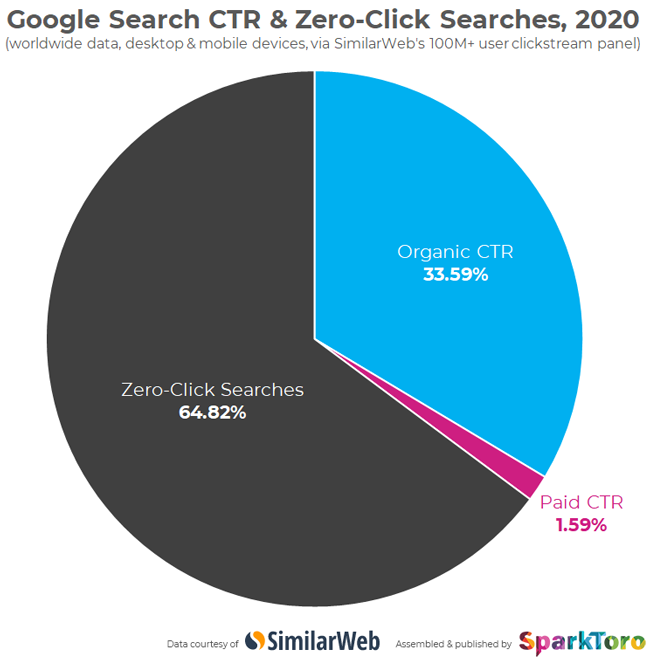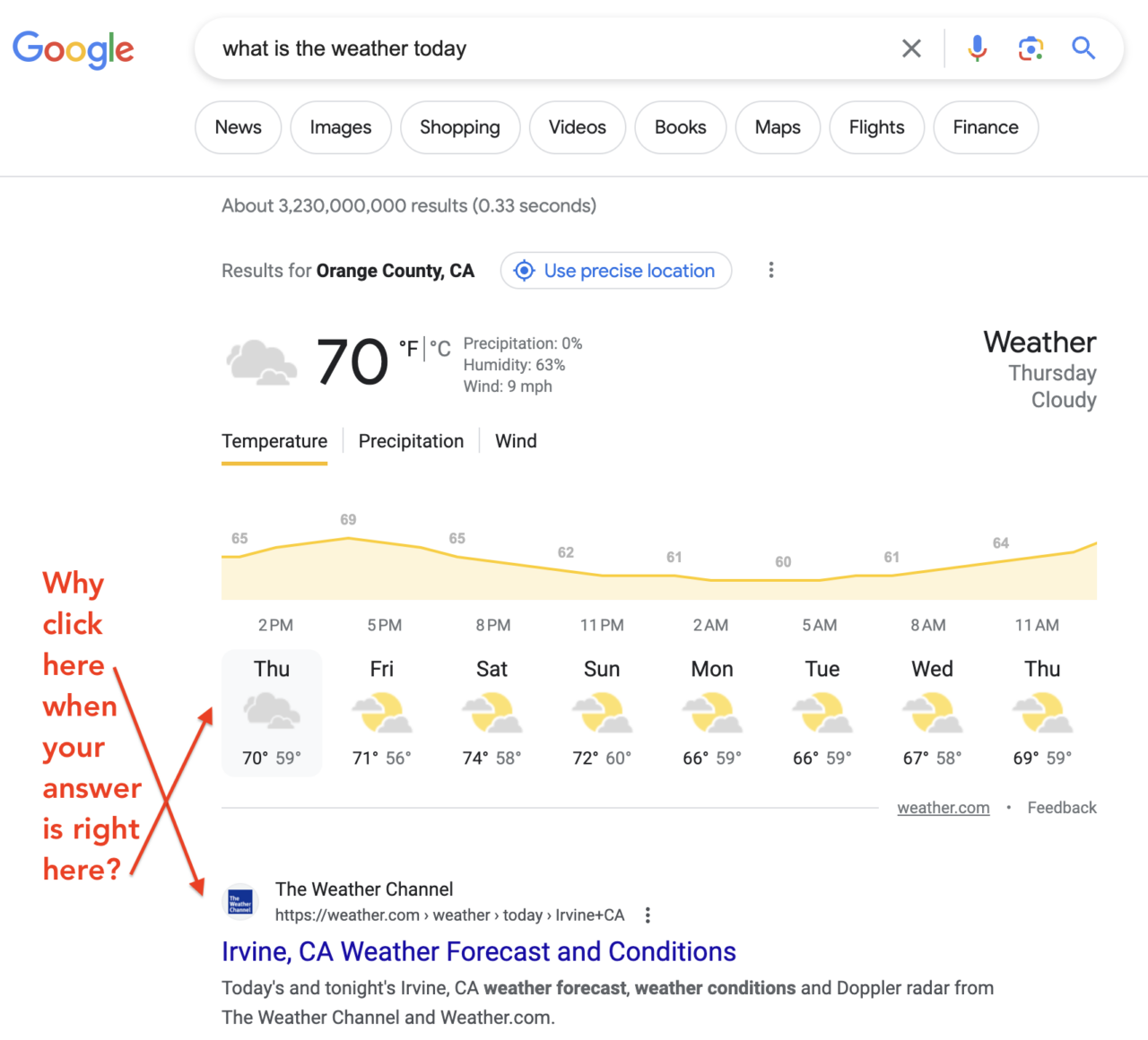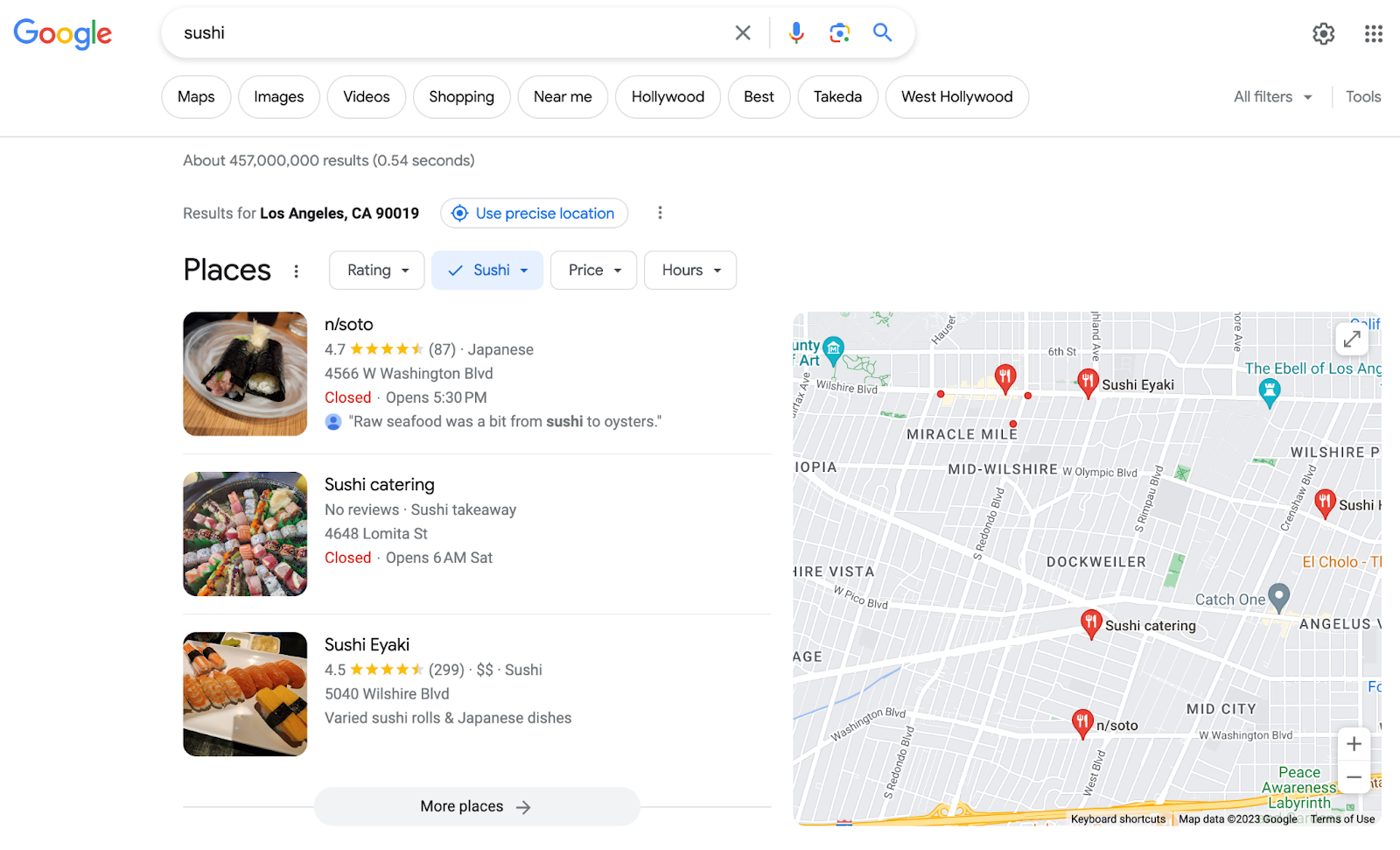Have you noticed a decrease in your website traffic? Is Google sending fewer clicks to websites? Or are webmasters just looking to blame someone for a drop in traffic?
Google’s role in digital marketing is unquestionable. It’s the largest search engine in the world and the go-to source for people seeking information. And marketers have become uber-reliant on this platform for the majority of their web traffic.
Recent data seems to suggest that Google search has been slowly sending websites fewer and fewer clicks over the last six months.
Let’s dive into this hot topic.
Google Website Traffic: What the Data Shows
Peter Caputa, CEO of Databox, a company that compiles a lot of data from different companies, posted this on LinkedIn a few days ago:

This is the image he posted:

He goes on to sum up:
Search impressions up. Clicks up too, but not as much. Click-through rate down.
Finally, he concludes his post with:
“Now, I don’t want to claim that our sample of 1,526 companies are representative of the web, but I don’t have another way to explain this drop other than the fact that Google may be purposefully sending fewer clicks by showing featured snippets, knowledge panels, videos, etc.
Perhaps another explanation is that people are just not finding what they’re looking for, so they aren’t clicking?”
He includes the source and full access to data, plus ability to drill down by industry and company size.
Dive Deeper: 14 Ways to Increase Your Website Traffic (+ Top 10 Tools)
Search Behavior: Impressions Versus Click-Throughs
And so Caputa is basically saying that their data doesn’t support this theory. According to Databox, search impressions are up, meaning that people are using Google more than ever. But paradoxically, the median click-through rate has been going down over the past six months.
The click-through rate means that someone could end up seeing your listing in the Google search results, but they may not click through to the website. They’re still searching, they’re just clicking less.
This suggests that users might be getting the answers they need directly from Google’s search results, eliminating the need to click through to a website. This could be due to Google’s efforts to refine its Search Generative Experience (SGE), giving users answers without needing to navigate away from the search page.
The trend of declining clicks is not only limited to Google; it’s also happening on other search engines like Bing and Yahoo. So the natural inclination from marketers is that the behavior is changing. You have TikTok, you have people searching directly on Amazon, you have Reddit, ChatGPT doing your search for you.
The reason is that search behavior is changing.
Many users now prefer to get their answers within the search results, without clicking through to the website. Google has improved its algorithms, providing people with the information they need in the SERPs itself. This means that users now have a rich snippet (features beyond the basic blue link format) of information, which leads to zero-click searches.
Dive Deeper: 11 Proven Hacks to Increase Your Organic CTRs
The Rise of Zero-Click Searches
Rand Fishkin, the former founder of Moz who now has a company called Spark Toro, shared similar web data showing that clickstream data, basically the share of zero-click searches, showed an exponential increase year over year:

His data showed that:
- In August of 2019, 50.33% of all Google searches ended without a click.
- By December of 2020, 64.82% of all Google searches (desktop and mobile combined) ended without a click.
This suggests a shift in how users interact with Google, possibly resulting in fewer clicks to websites over time. And his theory is that this is going to continue to increase.
Zero-click searches have become a hot topic of discussion in the world of SEO and digital marketing. With the advent of voice search and smart assistants, people are increasingly relying on search engines to provide them with quick and accurate answers that they don’t have to visit a website for.
This is often the case with simple queries, such as “what is the weather today?” or “what time is it in New York?” In these instances, Google displays the answer at the top of the SERPs, along with other related information, such as a map or a featured snippet.

While zero-click searches may seem like a convenience for users, they have significant implications for website owners and marketers. With more than half of all searches resulting in zero clicks, businesses are finding it increasingly difficult to get more website traffic. This is especially true for small businesses that rely on organic search traffic to drive sales and revenue.
Dive Deeper:
* Featured Snippets: How to Optimize for Position Zero
* How Zero Search Volume Keywords Can Generate a Ton of Traffic
The Impact on Google’s Ad Revenue
Google generates a significant portion of its revenue from ads, and drastic changes could affect this income stream.
While zero-click searches can be convenient for users, they can be detrimental to Google’s ad revenue. If users are not clicking on the ads displayed in the SERPs, then Google is not earning revenue.
Naturally, Google has been taking steps to counteract the impact of zero-click searches on its revenue. One way it has done this is by increasing the number of ads displayed in the SERPs. In addition to the traditional ads displayed at the top and bottom of the page, Google has also started displaying ads for local businesses in the “local pack” section of the SERPs:

By displaying more ads, Google is increasing the chances that users will click on one of them, even if they don’t click on any of the organic search results. This means that while the click-through rates for individual ads might decline, the overall revenue generated from Google Ads could remain steady.
Another factor to consider is the quality of the ads themselves (ad quality score). If advertisers are able to create compelling ads that are relevant to users’ search queries, then they are more likely to receive clicks, even in a world dominated by zero-click searches. This means that advertisers will need to focus on creating high-quality ads that resonate with their target audience.
Dive Deeper:
* 7 Key Benefits of Using Responsive Display Ads
* 5 Great PPC Tools to Crush Your Competitors
* Best Google Ads Agency: Top 5 Choices for 2023
Balancing User Experience and Content Creation Incentives
If Google continues to decrease site click-throughs, it might disincentivize people from publishing content to be indexed by Google.
But Google’s search liaison, Danny Sullivan, claims that Google has consistently driven more traffic to websites each year since its inception.
Google’s goal is to provide the users with the best experience possible. This means that they are not merely looking for click-bait content but rather genuine and useful information. Thus, the search giant has been tweaking its algorithmic policies to prioritize high-quality content.
However, this has caused a controversy about how much value websites should get from clicks:
- On one hand, website owners argue that they should be compensated for the effort and resources they put into creating high-quality content. They argue that content creation is not an easy task, and it requires a considerable amount of time, energy and resources. Therefore, they should be rewarded for their efforts in the form of clicks and traffic.
- On the other hand, Google argues that the user experience should be the top priority. The search giant believes that users should be able to find the information they are looking for quickly and easily. Therefore, Google’s algorithmic policies prioritize high-quality content that provides value to the users.
The truth is that both sides have valid points. Websites should be compensated for their efforts in creating high-quality content. At the same time, the user experience should be the top priority. The challenge is to find a balance between the two.
Dive Deeper: How to Write Content for People and Optimize It for Google
What You Can Do to Continue Getting Clicks to Your Website
So what does this mean for businesses and website owners who rely on search engine traffic to generate leads and sales? It means that they need to adapt their SEO strategies to stay relevant and visible to their target audience.
Though Google is making every effort to be the ultimate source of information, website owners and businesses can continue to increase the click-through rate to their websites.
Here are a few things you can do:
- Use rich snippets to provide more information than the standard title, URL and meta description in the SERPs. They make search results more informative, visually appealing, and user-friendly. Some common types of rich snippets include: reviews, recipes, events and FAQs.

- Optimize for featured snippets, which are the information boxes that appear at the top of the search results. These snippets provide users with a quick answer to their query, and they still include a prominent link to the website that provided the information. People will usually click on this if the featured snippet answers their question but they still want to know more.

- Experiment with voice searches. When users make a voice search query, they’re given one answer, similar to the featured snippet. That rank zero snippet is how you can get your content in front of users via voice search.
- Don’t rely only on organic traffic from Google. Businesses should use a multi-channel approach, like social media and email marketing, to reach their target audience. By creating a strong brand identity and engaging with your audience on social media, you can build trust and credibility with your target audience, which can help to drive traffic to your website even if users are not clicking through from the SERPs.
- Keep improving the content of your website, making sure that your content is informative, engaging, and valuable to the user. Highlighting this info in the title and meta description will increase the chances of the user clicking through to the website to learn more about the topic.
- Update or create your Google My Business listing. Not all zero-click searches are bad news for businesses – if you have a GMB listing. These listings provide more info about the business, such as its address, phone number, and hours of operation.
Dive Deeper: How to Increase Website Traffic for SaaS Companies
The Future of Google’s Click Trends
While data suggests Google may be sending fewer clicks to websites, this doesn’t necessarily spell doom for marketers or content creators.
As long as Google continues to balance user experience with incentivizing content creation, and evolves its strategies with careful consideration, it is likely that websites will continue to receive healthy traffic from the search engine giant.
If you’re getting fewer clicks to your website, Single Grain’s SEO and paid ads experts can help. 👇



